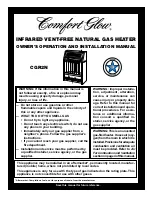
35
LEAKING TEMPERATURE AND PRESSURE RELIEF VALVE
SYMPTOMS
• Water seeping around the relief valve tank connection.
• Leakage at the threaded portion of the relief valve connection.
• Intermittent weeping and/or dribbling from the relief valve.
• Large volume of hot water sporadically discharged from the relief valve.
CAUSE
The temperature and pressure relief valve (T&P) is a safety device limiting temperature and pressure
levels in a water heater. Each T&P has both a temperature and pressure rating. Normally, the
temperature and pressure relief valve will have a temperature rating of 210°F. A probe (part of the
relief valve) extends into the tank measuring the stored water temperature. This probe must be within
the top six inches of the water heater. If the water heater’s thermostat malfunctions, higher than
normal water temperatures could be produced. Once the probe senses a temperature approaching
its temperature rating, the relief valve will open to full capacity releasing “very hot” water until the
temperature is below its reset temperature. The pressure rating on the relief valve should be the
same or less than the certi
fi
ed working pressure of the tank (generally 150 psi) and be below the
lowest maximum working pressure rating of any system components. Once the pressure in the tank
reaches the valve’s pressure rating, it will slightly open relieving the pressure. Relieving of pressure
can be noted as “dribbling” or “weeping” water from the relief valve. If an incorrectly sized temperature
and pressure relief valve is installed, the warranty will be void.
THE FIX
Follow these easy steps to diagnose thermal expansion:
• Intermittent weeping and/or dribbling at the relief valve - The relief valve relieves water slowly
when actuating on pressure. A closed system can cause pressure to increase in the system. This
condition is called thermal expansion. For additional information regarding thermal expansion
please see thermal expansion section on of the Installation and Operating Manual.
• Leaking at the spud of the water heater - Spuds are welded to the tank and are not repairable. The
heater should be replaced.
• Leakage at the threaded relief valve connection - Remove relief valve and reseal connection.
• Large volume of hot water sporadically discharged from the relief valve – The relief valve relieves
water quickly when actuating on temperature. The only cause of this problem is a malfunctioning
thermostat.
INSULATION BLANKETS
GENERAL
The purpose of an insulation blanket is to reduce the standby heat loss encountered with storage tank
heaters. Most modern water heaters have adequate factory installed insulation, the use of an after
market insulation blanket is no longer recommended by most experts. While the use of an external
insulation blanket will not void the warranty, the water heater manufacturer explicitly disclaims any
liability for problems associated with the use of insulation blankets.
Note:
A few local energy codes
may still require the use of insulation blankets on waters heaters. Be sure to follow all installation
instructions, cautions, and warnings for the insulation blanket as well as the cautions and warning
of the water heaters owners manual.
NOTES
Should you choose to apply an insulation blanket to this heater, you should follow these instructions.
Failure to follow these instructions can restrict the air
fl
ow required for proper combustion, resulting
in
fi
re, asphyxiation, serious personal injury or death.
• Do not cover the outer door, thermostat or temperature & pressure relief valve.
• When installed the insulation blanket will cover important safety and operation labels. Obtain new
warning and instruction labels from the Technical Information Center listed in the owners’ manual.
The replacement labels must be placed on the blanket in the location of the original labels on the
water heater jacket.
• Do not cover the instruction manual. Keep it on the side of the water heater or nearby for future
reference.
• Do not apply insulation to the top of the water heater, as this will interfere with safe operation of
the draft hood.
• Do not allow insulation to come within 2” of the rear air duct of the water heater to prevent blockage
of combustion air
fl
ow to the burner. The combustion air openings in the rear air duct of the water
heater must NOT be obstructed.
• Inspect the insulation blanket frequently to make certain it does not sag, thereby obstructing
combustion air
fl
ow.





































